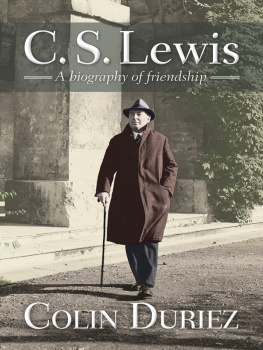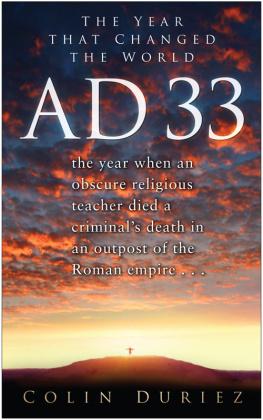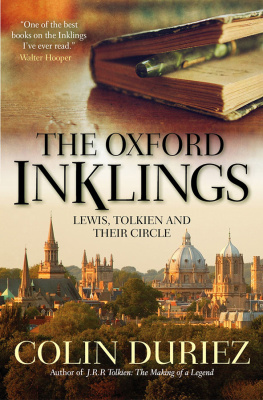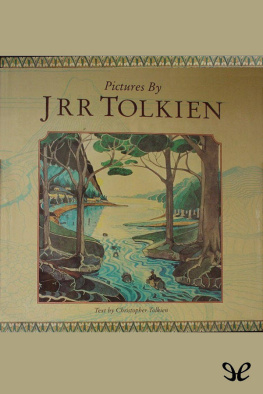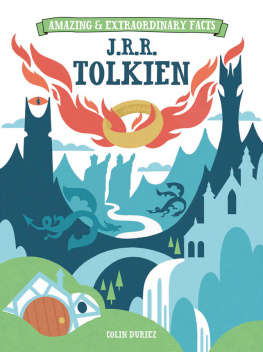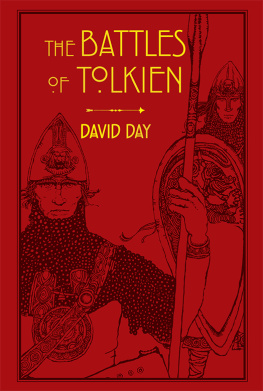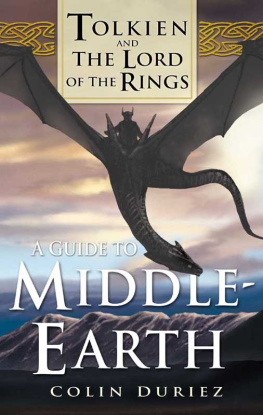Colin Duriez - J. R. R. Tolkien The Making of a Legend
Here you can read online Colin Duriez - J. R. R. Tolkien The Making of a Legend full text of the book (entire story) in english for free. Download pdf and epub, get meaning, cover and reviews about this ebook. year: 2012, publisher: Lion Books, genre: Non-fiction / History. Description of the work, (preface) as well as reviews are available. Best literature library LitArk.com created for fans of good reading and offers a wide selection of genres:
Romance novel
Science fiction
Adventure
Detective
Science
History
Home and family
Prose
Art
Politics
Computer
Non-fiction
Religion
Business
Children
Humor
Choose a favorite category and find really read worthwhile books. Enjoy immersion in the world of imagination, feel the emotions of the characters or learn something new for yourself, make an fascinating discovery.
- Book:J. R. R. Tolkien The Making of a Legend
- Author:
- Publisher:Lion Books
- Genre:
- Year:2012
- Rating:4 / 5
- Favourites:Add to favourites
- Your mark:
- 80
- 1
- 2
- 3
- 4
- 5
J. R. R. Tolkien The Making of a Legend: summary, description and annotation
We offer to read an annotation, description, summary or preface (depends on what the author of the book "J. R. R. Tolkien The Making of a Legend" wrote himself). If you haven't found the necessary information about the book — write in the comments, we will try to find it.
J. R. R. Tolkien The Making of a Legend — read online for free the complete book (whole text) full work
Below is the text of the book, divided by pages. System saving the place of the last page read, allows you to conveniently read the book "J. R. R. Tolkien The Making of a Legend" online for free, without having to search again every time where you left off. Put a bookmark, and you can go to the page where you finished reading at any time.
Font size:
Interval:
Bookmark:


Copyright 2012 Colin Duriez
This edition copyright 2012 Lion Hudson
The right of Colin Duriez to be identified as the author of this work has been asserted by him in accordance with the Copyright, Designs and Patents Act 1988.
All rights reserved. No part of this publication may be reproduced or transmitted in any form or by any means, electronic or mechanical, including photocopy, recording, or any information storage and retrieval system, without permission in writing from the publisher.
Published by Lion Books
an imprint of
Lion Hudson plc
Wilkinson House, Jordan Hill Road,
Oxford OX2 8DR, England
www.lionhudson.com/lion
ISBN 978 0 7459 5514 8
e-ISBN 978 0 7459 5709 8
First edition 2012
Praise for J.R.R Tolkien
J.R.R. Tolkien created a new form of literary legend with his histories of Middle-earth and, as result, has himself been accorded legendary status. Colin Duriez, who is well versed in the ways of Hobbits and other denizens of Tolkiens world, presents an engaging, intimate account of the authors life and work and the phenomenon that both have become. At a time when writings about Tolkien far outnumber writings by him, it is good to be able to commend such a well-researched and highly readable biography that captures the essence of the man and enables us to better understand and appreciate his extraordinary achievement.
Brian Sibley
Author of The Hobbit: An Unexpected Journey
Official Movie Guide
Acknowledgments
Excerpts from Tolkien and C.S. Lewis: The Gift of Friendship , Copyright 2003 by Colin Duriez, Paulist Press, Inc., NewYork/ Mahwah, N.J. Used with permission of Paulist Press. www.paulistpress.com
pp. 14, 104, 199: Now Read On radio interview with J.R.R. Tolkien reprinted by permission of BBC Radio 4.
pp. 1920, 21, 3839, 41, 42, 45, 51, 66, 78, 7879, 80, 94, 115, 128, 130, 13435, 138, 139, 158, 16768, 189: From J.R.R. Tolkien: A Biography copyright 1977 by Humphrey Carpenter. Reprinted by permission of HarperCollins Publishers Ltd. pp. 2526, 2930, 46, 52, 53, 81, 109, 118, 191, 198, 201: From The Letters of J.R.R. Tolkien copyright 2006 edited by Humphrey Carpenter. Reprinted by permission of HarperCollins Publishers Ltd.
p. 44: From J.R.R. Tolkien: Author of the Century copyright 2001 by Tom Shipy. Reprinted by permission of HarperCollins Publishers Ltd.
pp. 31, 58, 60, 143: The Times obituary of J.R.R. Tolkien written by C.S. Lewis reprinted by permission of The Times/NI Syndication.
pp. 8384: From J.R.R. Tolkien Encyclopedia copyright 2007 by Michael D.C. Drout. Reprinted by permission of Routledge/ Copyright Clearance Center.
pp. 83, 89, 91, 95, 105: From Tolkien and the Great War copyright 2005 by John Garth. Reprinted by permission of HarperCollins Publishers Ltd.
pp. 115, 116: From The Ring of Words: Tolkien and the Oxford English Dictionary copyright 2006 by Peter Gilliver, Jeremy Marshall and Edmund Weiner. Reprinted by permission of Oxford University Press.
p. 135: From The Tolkien Relation copyright 1968 by William Ready.
p. 136: From Memoirs copyright 1992 by Kingsley Amis. Reprinted by permission of The Random House Group Limited and The Wylie Agency.
p. 147: From The Inklings: C.S. Lewis, J.R.R. Tolkien, Charles Williams and their friends copyright 1979 by Humphrey Carpenter. Reprinted by permission of HarperCollins Publishers Ltd and C.S. Lewis Pte Ltd.
p. 150: Extracts by C.S. Lewis copyright C.S. Lewis Pte Ltd.
p. 166: From C.S. Lewis: Memories and Reflections copyright 1998 by John Lawlor. Reprinted by permission of Spence Publishing Company.
p. 202: From Proceedings of the J.R.R. Tolkien Centenary Conference 1992 copyright 1995 edited by Glen H. GoodKnight and Patricia Reynolds. Reprinted by permission of Mythopoeic Society.
p. 184: From Arthurian Torso copyright 1948 by C.S. Lewis. Reprinted by permission of The C.S. Lewis Company Ltd.
p. 204: Review of The Return of the King in the New York Times copyright 1956 by W.H. Auden. Reprinted by permission of Curtis Brown, Ltd.
p. 203: From Brothers and Friends: The Diaries of Major Warren Hamilton copyright 1988 by Clyde S. Kilby and Marjorie Lamp. Reprinted by permission of HarperCollins Publishers Ltd.
Cover photo Pamela Chandler/ ArenaPAL/TopFoto
A catalogue record for this book is available from the British Library
To
Abigail Perriss,
Max Hopson Ferris
and
Poppy Webb
Foreword
T here it was in the bookshop. A book called The Hobbit with a cover picture of a dragon soaring, an arrow embedded in his breast. I picked it up and opened it the runes and end paper maps were intriguing. Quickly I bought the book and was soon following Bilbos adventures as he made his way towards the Lonely Mountain. The authors name I recognized as a close friend of C.S. Lewis, an author I had recently discovered. I was reading his autobiography, Surprised By Joy , at the time.
The next time I visited the library, I looked under T. The three red cloth-bound volumes stood out. In great excitement I opened them. The Fellowship of the Ring had much more about Hobbits. I borrowed it, the first of the three volumes of The Lord of the Rings , and began another stage of discovery.
Today, it is difficult to imagine a world without J.R.R. Tolkiens stories of Middle-earth and Elves, Wizards, and Hobbits. His is a household name from Tunbridge Wells to Toronto, Kyoto to Cape Town. Long before the successful movies, the books of The Hobbit and The Lord of the Rings had a global popularity. Their devoted readers included plumbers and postgraduate students, IT specialists and rich merchant bankers, car mechanics and teachers, pensioners and children. The Tolkien phenomenon began within the cultural upheavals of the sixties and created an unprecedented demand for fantasy and otherworldly stories like the Harry Potter series, the Twilight series, and others that fill large sections of bookstores around the planet.
Who was the man who became a legend? Where did the stories and underlying mythology of Middle-earth come from? This is the story of an intensely private, brilliant, and eccentric professor in a specialist university discipline whose imagination was in touch with our basic hunger for stories that, like all stories that have stood out and survived over the ages, nourish the spirit. When he sought to get The Lord of the Rings the fruit of a dozen or so years of writing into print, he had difficulty in settling on a publisher. When he did, his publisher, though enthusiastic, treated the work as a loss-making venture, little realizing the wealth it would create both for the company and its author. Tolkiens own life was hit hard as an orphan suffering financial hardship. His guardian for three years forbad him to even communicate with the woman with whom he had fallen in love. After his brilliance was eventually recognized at Oxford, he was traumatized by his service in the Battle of the Somme in the First World War.
That is only part of the story of J.R.R. Tolkien. Behind the depths and richness of The Lord of the Rings is over fifty years of creation accompanying the languages, history, peoples, and geography of Middle-earth, with a consistent mythology and body of legends inspired by a formidable knowledge of early northwest European history and culture. Tolkien only became a legend by making a legend that has gripped the imagination of an astonishing variety of people throughout the world.
There are a couple of technical necessities I need to point out. One is that I have kept to Tolkiens own pluralization of Dwarf as Dwarves when referring to such characters in his stories. As has become the custom when writing about Tolkien, the second is the necessity of distinguishing The Silmarillion published in 1977 (four years after Tolkiens death) from the vast number of unfinished drafts of stories, annals, lexicons, and accounts of the development of Elvish languages that Tolkien left upon his death. This vast repository is indicated as The Silmarillion, because it was drafted as a particular part of the imagined history of Middle-earth that concerned the precious gems called the Silmarils, or relates to that period as its past or its future. The Silmarillion of 1977 is a concise and authoritative version drawn from the extant material, and edited by Tolkiens son, Christopher Tolkien.
Next pageFont size:
Interval:
Bookmark:
Similar books «J. R. R. Tolkien The Making of a Legend»
Look at similar books to J. R. R. Tolkien The Making of a Legend. We have selected literature similar in name and meaning in the hope of providing readers with more options to find new, interesting, not yet read works.
Discussion, reviews of the book J. R. R. Tolkien The Making of a Legend and just readers' own opinions. Leave your comments, write what you think about the work, its meaning or the main characters. Specify what exactly you liked and what you didn't like, and why you think so.


